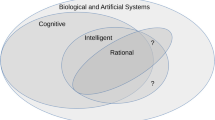Abstract
The paper examines the nature of the behavioral evidence underlying attributions of intelligence in the case of human beings, and how this might be extended to other kinds of cognitive system, in the spirit of the original Turing Test (TT). I consider Harnad's Total Turing Test (TTT), which involves successful performance of both linguistic and robotic behavior, and which is often thought to incorporate the very same range of empirical data that is available in the human case. However, I argue that the TTT is still too weak, because it only tests the capabilities of particular tokens within a preexisting context of intelligent behavior. What is needed is a test of the cognitive type, as manifested through a number of exemplary tokens, in order to confirm that the cognitive type is able to produce the context of intelligent behavior presupposed by tests such as the TT and TTT.
Similar content being viewed by others
References
Harnad, S. (1991), ‘Other Bodies, Other Minds: A Mahcine Incarnation of an Old Philosophical Problem’, Minds and Machines 1 pp. 43–54.
Schweizer, P. (1994), ‘Intentionality, Qualia and Mind/Brain Identity’, Minds and Machines 4, pp. 259–282.
Searle, J. (1980), ‘Minds, Brains and Programs’, Behavioral and Brain Sciences 3, pp. 417–424.
Turing, A. (1950) ‘Computing Machinery and Intelligence’, Mind 59, pp. 433–460.
Author information
Authors and Affiliations
Rights and permissions
About this article
Cite this article
Schweizer, P. The Truly Total Turing Test* . Minds and Machines 8, 263–272 (1998). https://doi.org/10.1023/A:1008229619541
Issue Date:
DOI: https://doi.org/10.1023/A:1008229619541



